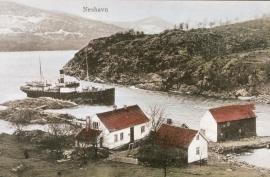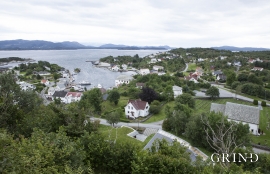- Remove Small landforms filter Small landforms
- Remove Maritime environments filter Maritime environments
- Remove Place filter Place
- Remove Factories filter Factories
- Remove Trading posts and guesthouses filter Trading posts and guesthouses

Salhus
Salhus has been a connecting point for sea travellers far back in time. The name probably derives from the Old Norse word sáluhús, “house for travellers”. The name may indicate that this was a place for an inn even in the Middle Ages. The place is eminently situated in the route to and from Bergen. For travellers coming by boat from Sogn and Nordhordland, Salhus is the last stop before Bergen. Travellers from the communities in Voss also came this way earlier when they were going to Bergen


Otterstad
Tthe Otterstad farms lie in the innermost part of Mofjorden, on the northwest side of the river. The row of stave-built boatsheds that belong to the farm were probably constructed a little after the middle of the 1800s. Both here and on the Mo side, the boatsheds were important storage places at the seashore; wood and other farm products intended for the town; corn and merchandise in return.

Odda- The tourist town
The pioneering tourists in the 1830s-40s brought a momentum in the tourist traffic to the fjord and mountain country Norway. At the time Odda was a hidden Shangri-La at the bottom of Sørfjorden; the farm and the church on the green headland at the fjord. But when the steamship traffic opened the fjord landscape for tourism, in a few years Odda parish in Søndre Bergenhus County became the focal point for travellers in West Norway.

Odda- The industrial town
In 1908 the new power station in Tyssedal was completed. A/S Tyssefaldene provided power for the carbide and cyanide factory that was built in Odda. This signalled a new era.

Notaholmen
The fishnet shed at Notaholmen stands as a reminder of the days when people used to row out on the fjord to set their nets. On Notaholmen the nets were dried, repaired and tanned. And it was a great advantage to store them in a place inaccessible for rats and mice.

Neshamn
Neshamn must be an ancient place for meeting and spending the night for travellers. The place blossomed in connection with the times of economic expansion in the 1500s, which to a large extent was linked to the Scottish trade at this time. Neshamn was a loading place for Scottish ships for two hundred years, up to the middle of the 1700s.

Mosterhamn
Mosterhamn is one of the old privileged trading posts situated centrally in the shipping lane, whether the ships sailed on Langenuten, Nyeleia through Fitjar or into the Hardanger Fjord. From prehistoric times Bømlo and Moster were the first landing places when arriving from the west; a landscape with good harbours.

Mosnes
The permanently-protected Mosneselva River, with its meltwater from Folgefonna, runs out into Åkra Fjord by the roadless and uninhabited Mosnes. Those who once lived here were forced to surrender to the ravages of Nature. In the autumn of 1962 there was a flood so great that the people were driven from their farms.

Mjøsvågen
Around Mjøsvågen here is still a compact marine use area. Some of the buildings are common boathouses, but most of them also house small enterprises and workshops. This is where the farmers from Øvsthus, Mjøs, Hole and other farms have supplemented their meagre incomes as smiths, brass moulders, clog makers, chest builders and decorative painters.


